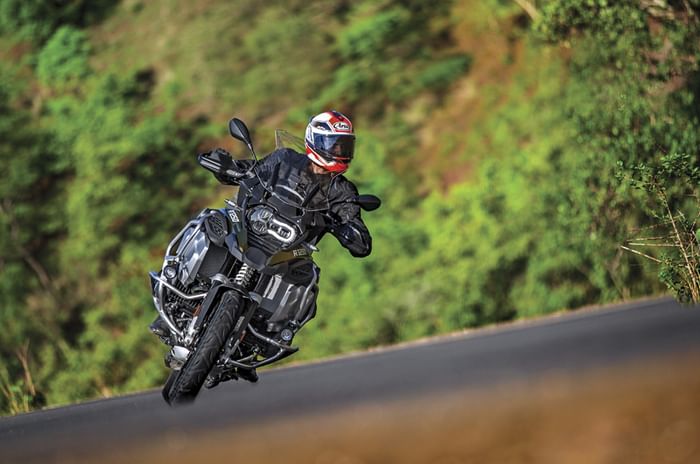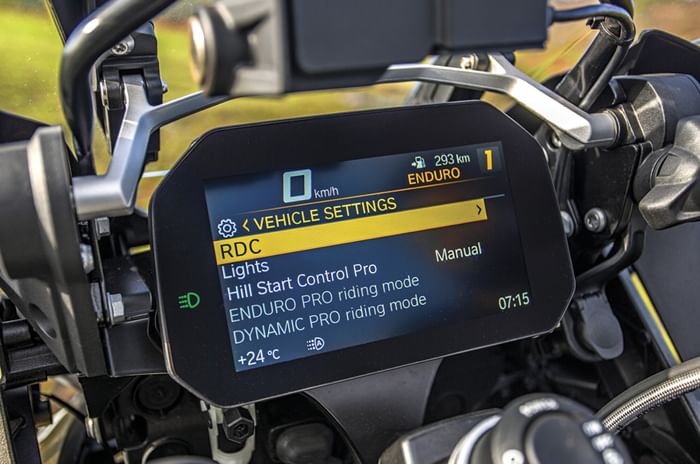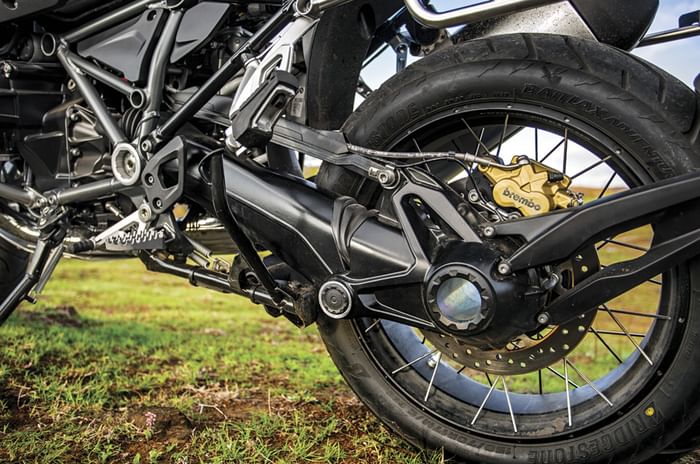The big BMW GS is a living icon. There’s almost no mainstream motorcycle on sale today that is as unique or revered for its capabilities. The full-size GS takes such a left-of-field approach to things like the suspension and powertrain that it is probably the most unfamiliar and ‘different’ riding experience I’ve ever come across this side of riding an EV. Riding this bike was extra special for me because aside from a good friend’s old R 1150 GS from 2001, I have no experience with BMW’s big boxer-twin ADVs. So beyond the standard review, what you’re about to read is the impression this unique machine can make on an unfamiliar rider.
Big daddy
The very first emotion is anxiety; fear, even. This bike is comically large, and even though I’ve ridden bikes that weigh over a 100kg more, given the R 1250 GS Adventure’s sheer height and girth, the thought of threading it through Pune’s traffic formed a small lump in my throat. And therein comes the first of many new experiences. The GS feels so much easier to ride than its vast presence would have you believe. The effort required at the steering feels strangely light, and that’s because the unique Telelever front end, with its centrally mounted shock absorber, allows for the use of a slim 37mm fork, and that saves a lot of weight. You know what else has a 37mm fork? A Hero Xtreme 200R.
Another big contributor to the GS’ easy and super-stable feel is the low-slung 1,254cc boxer engine. This keeps weight as low as possible, further contributing to the feeling of lightness, despite the ginormous fuel tank between your legs. And what a character-filled motor this is. Gaining about 50cc for 2019, it starts up with a deep baritone note that sounds somewhere between your typical V-twin and parallel-twin engine notes.

Throttle smoothness has been tuned to perfection and the GS quickly laughed off a preconceived notion I’d held for years. For some reason, I always imagined the GS to be a big softie – a gentle giant, if you will. But opening the throttle at the first stretch of open road, sucker-punched that idea right out of my head. To be fair, I should have known better; 136hp and 143Nm are no joke, but what really got to me was how hard-hitting the low- and mid-range performance is. BMW’s new Shiftcam variable camshaft control system blesses an already torque-laden motor with what is now knockout mid-range performance and anything upwards of 3,000rpm is seriously quick. I spent the entire day between 3,000 and 6,000rpm, and the only time I found the 9,000rpm rev limiter was when I actively went looking for it; at this point it becomes clear that the mid-range is this engine’s happy place.

The engine and gearbox have a solid, indestructible feel, although the up/down quickshifter isn’t as precise as it should be. There’s the usual raft of riding modes, and because this is the Pro Model that we’re riding, it packs an additional Dynamic Pro and Off-Road Pro mode that can be set up as per the rider’s preferences. The Pro model also brings in electronically controlled suspension damping at both ends, which means you have control over the ride and handling character through the riding modes as well.
Keep rolling
Fifteen minutes into riding the GS, clarity begins to appear as to why this bike has grown into the legend it is. It just feels built to never stop, a fact highlighted by the 30-litre (thirty!) fuel tank. The motor doesn’t quite shock you with superbike performance like a Multistrada would, but instead it feels like the Airbus A380 of motorcycles – huge, effortless and ready to cross continents. Ride quality in Road mode feels a bit like an air-bus too – the soft and wallowy feel reminds you of being in a Volvo bus. In this mode, the GS floats along with a reassuringly detached feel, but hit a deep enough pothole and the suspension lets you know that while it can easily handle it, it doesn’t particularly like it.
Soon enough, you and your GS will discover a deliciously winding road, at which point you switch to Dynamic mode that firms the suspension up noticeably. Handling is fairly impressive, but it does take some getting used to the fact that the Telelever front end doesn’t compress much under braking like a normal fork would. In that respect, the Paralever rear suspension, which is hooked up to the big drive shaft, feels more natural in its function. Those of you concerned about what happens to those protruding engine cases when the bike leans over – fret not, there’s more than enough cornering clearance on offer.

Good roads don’t last very long in this part of the world and that’s of no concern to the GS because it will go wherever you point it. Riding this bike off-road is more down to the rider’s confidence than the bike’s capabilities. If you know what you’re doing, you can jump and slide this 268kg behemoth around all day. But in all honesty, this is the kind of bike I’d use to confidently cross any obstacles I come across on my journey, instead of looking for them just for fun.
The wonderful uniqueness of the GS continues in urban traffic. I had the good fortune of getting stuck in a monumental traffic jam caused by the annual Palkhi pilgrimage in Pune (Google it to get an idea of what I’m on about). Yes, the bike occupies nearly as much space as a rickshaw, so filtering through tight spaces isn’t going to happen, but I could think of worse bikes I could have been on. The BMW’s clutch is nice and light, but the big joy is in the weird lack of heat from the engine. In fact, I found that it was my upper body getting hot thanks to the incredible wind protection from all that wide bodywork.
In that sense, the ergonomics are superb for a tall rider, whether you sit or stand. The only quality-related quirk I could find was that the mirror stalk makes contact with the manually adjustable windscreen when it’s set in its lowest position – most un-BMW that. As for the design... well, it’s purposeful, but that’s about it, especially given the kilometres worth of exposed steel tubing all over.

Living with the legend
Spending just a day with the R 1250 GS Adventure has been enough to shed light on why it’s so revered and for me to have developed a deep sense of respect. With prices starting at Rs 18.25 lakh for the Standard model and Rs 21.95 lakh for the Pro, this is definitely not a bike for everybody. If it’s instant gratification you’re after, the Ducati Multistrada 1260 will hit the spot much harder, and it’ll save you a few bucks in between, but I can’t shake the suspicion that if the GS and I were to go on a long journey over many thousands of kilometres, that’s when true love will blossom. If you want to channel your inner Ewan McGregor and go the ‘long way round’, this probably remains the most accomplished motorcycle in the world to take along with you.










.jpg?w=728&q=75)
.jpg?w=728&q=75)

.jpg?w=728&q=75)



























